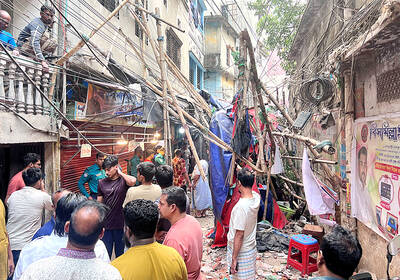Staring out from an ancient piece of pottery, the mysterious face of a bearded man has given scientists a unique glimpse of what the first settlers of Fiji may have looked like.
Researchers say the "extraordinary discovery" is a vital clue in mapping out how the South Pacific came to be inhabited some 3,000 years ago, suggesting the first direct link to islands some thousands of kilometers away.

PHOTO: AFP
Thought to be the work of the Lapita people -- a long-lost race which originated near modern-day Taiwan then migrated to Polynesia -- the fragment is also at least 200 years older than any other piece found in Fiji.
"This is the first time that a clearly recognizable face design made in three dimensions on a piece of Lapita pottery has been found in Fiji," said a statement from the University of the South Pacific, based in the archipelago.
Preliminary analysis shows that the eerie-looking face consists of a prominent raised nose, the left eye and what might be eyelashes, said Roselyn Kumar of the University of the South Pacific's Institute of Applied Sciences.
There are also designs that suggest what might be head-hair, and crescent shapes on the base which were possibly intended to represent beard-hair.
The find therefore gives researchers an opportunity to gaze on the countenance of Fiji's first inhabitants, from whom modern Polynesians are believed to be descended.
But equally significant is that it is the first time that a facial design has been found on Lapita pottery outside a group of islands north of Papua New Guinea -- which are some 3,400km away from Fiji.
"As such it represents an extraordinary discovery," the university said.
The find made it possible to conclude that the early people of Fiji had at some stage come from the far-off island chain, named the Bismarck Archipelago, Geography Professor Patrick Nunn said.
It could go some way towards settling the long archaeological debate on the settling of Polynesia -- a vast triangle of islands from Hawaii in the north, to New Zealand in the south-east and Rapanui or Easter Island in the east.
The new face fragment was found near Natadola Beach, west of the Fijian capital Suva, in the tourist area of Viti Levu island.
Around 60 pottery pieces were found during excavations and radiocarbon dating established the shard with the face design was 3,260 years old -- whereas Fiji's next oldest-known Lapita settlement goes back only 3,000 years.
It was possible that Natadola was the first place of human settlement in Fiji, Nunn said.
He added that the analysis suggested that the designs were made using the unique Lapita technique of pot decoration known as dentate stamping, whereby lines are made from a series of tiny regularly-spaced dots applied to the pottery before it was fired.
"It was a very time-consuming and precise technique used to create intricate designs, perhaps associated with ancestor worship," he said.
More than 100 Lapita sites have been located over an area from New Guinea to western Polynesia, a distance of over 4,000km.
US archaeologist Edward Gifford gave the race their name after mishearing the indigenous name of a site in New Caledonia where he was working in 1952.
He had found shards of distinctive pottery there and recognized a link to similar finds to the north in New Guinea.

DISASTER: The Bangladesh Meteorological Department recorded a magnitude 5.7 and tremors reached as far as Kolkata, India, more than 300km away from the epicenter A powerful earthquake struck Bangladesh yesterday outside the crowded capital, Dhaka, killing at least five people and injuring about a hundred, the government said. The magnitude 5.5 quake struck at 10:38am near Narsingdi, Bangladesh, about 33km from Dhaka, the US Geological Survey (USGS) said. The earthquake sparked fear and chaos with many in the Muslim-majority nation of 170 million people at home on their day off. AFP reporters in Dhaka said they saw people weeping in the streets while others appeared shocked. Bangladesh Interim Leader Muhammad Yunus expressed his “deep shock and sorrow over the news of casualties in various districts.” At least five people,

The latest batch from convicted sex offender Jeffrey Epstein’s e-mails illustrates the extraordinary scope of his contacts with powerful people, ranging from a top Trump adviser to Britain’s ex-prince Andrew. The US House of Representatives is expected to vote this week on trying to force release of evidence gathered on Epstein by law enforcement over the years — including the identities of the men suspected of participating in his alleged sex trafficking ring. However, a slew of e-mails released this week have already opened new windows to the extent of Epstein’s network. These include multiple references to US President Donald

LEFT AND RIGHT: Battling anti-incumbent, anticommunist sentiment, Jeanette Jara had a precarious lead over far-right Jose Antonio Kast as they look to the Dec. 14 run Leftist candidate Jeannette Jara and far-right leader Jose Antonio Kast are to go head-to-head in Chile’s presidential runoff after topping Sunday’s first round of voting in an election dominated by fears of violent crime. With 99 percent of the results counted, Jara, a 51-year-old communist running on behalf of an eight-party coalition, won 26.85 percent, compared with 23.93 percent for Kast, the Servel electoral service said. The election was dominated by deep concern over a surge in murders, kidnappings and extortion widely blamed on foreign crime gangs. Kast, 59, has vowed to build walls, fences and trenches along Chile’s border with Bolivia to

DEATH SENTENCE: The ousted leader said she was willing to attend a fresh trial outside Bangladesh where the ruling would not be a ‘foregone conclusion’ Bangladesh’s fugitive former prime minister Sheikh Hasina yesterday called the guilty verdict and death sentence in her crimes against humanity trial “biased and politically motivated.” Hasina, 78, defied court orders that she return from India to attend her trial about whether she ordered a deadly crackdown against the student-led uprising that ousted her. She was found guilty and sentenced to death earlier yesterday. “The verdicts announced against me have been made by a rigged tribunal established and presided over by an unelected government with no democratic mandate,” Hasina said in a statement issued from hiding in India. “They are biased and politically motivated,” she